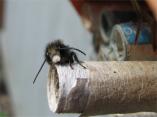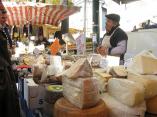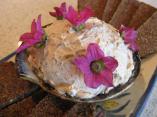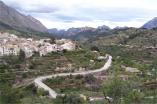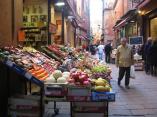On our second day in Spain, we headed to the University of Vic, also known as UVic (- and I guess, fair enough, they have more claim to the name than Victoria, which lacks a school of idioms).
On our way across campus, we passed a steely statue commemorating Catalonian poet, the letters of whose name had been picked off the base, so I can’t tell you who it was. But perhaps we can assume a towering intellect?
We had a presentation by a nouveau baker called Francesco Daviva who runs Forn de Pa Altarriba, where for 25 years he has been trying to radicalise bread. He talked about the shape of bread (there are only three: round, baguette, loaf/square), its presentation on restaurant tables, and the various ways of making it divisible for diners. Mediterranean tables seldom have bread plates, so there are issues about crumbs and cutting that quite naturally have to be considered: the sorts of things I suppose bakers used to instinctively incorporate into their work instead of giving a stand-up lecture. Although we passed a few rolls around to look at shape and colour and aroma, we were not offered anything material to chew on, and wandered off for an hour or so before reconvening for lunch in a campus cafeteria. (The bread at lunch was, well, unremarkable.)
It was blistering hot when we followed the leader to our next destination, Casa Riera Ordeix, to see some more sausage-making. Curious emblem over the door…
Fuet, (Salchichon de Vic) the sausage of Vic , has been made for about 150 years in the centre of Vic, run to this day as a family business. This was high quality meat: nothing but prime cuts of pork (well trimmed legs and pork belly for fat). They produce 3000 kg of sausage per week from January to July and then double the volume between September and Christmas, as it’s a product traditionally eaten at Christmas. They have a strictly scheduled week: Mondays they fill the casings; Tuesdays through Thursdays they trim the meat, as we saw:
Fridays they grind and season the meat, which is left to macerate over the weekend. The sausages are hung from nails in aging rooms where the temperature and humidity – much like prosciutto di parma – are regulated by opening and closing windows; the local flora of course play a part in the curing.
The sausages are brushed and re-hung periodically until they have done their two to three months’ stint. The product was absolutely delicious: spicy and peppery, firm and chewy. They sell the sausages everywhere in the world — except Canada and the US whose hygiene regulations exclude these and a great many artisanal products. (Hey y’all: the Europeans eat this stuff every day and are still standing…!)
(Except for the one who fell ill during the tour; perhaps heat, perhaps an early symptom of the flu that would catch up with her later.)
We packed our bags and headed to our next destination in Calafell, where we checked into the weird and somewhat horrible Hotel Solimar, a massive complex where we got to witness European-style mass tourism close up. Luckily our university escorts reviewed the offerings at the hotel buffet we were supposed to eat from that evening and realised it was in fact an inedible wasteland of fried and processed foods, prefixed by stacks of badly washed plates, and so we got to choose our meal in the somewhat better offerings along the seafront.

